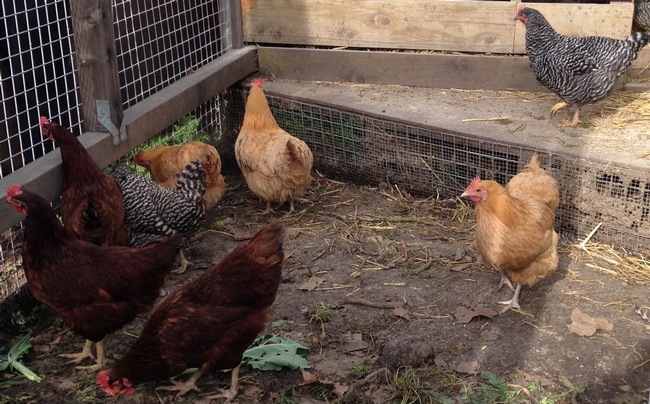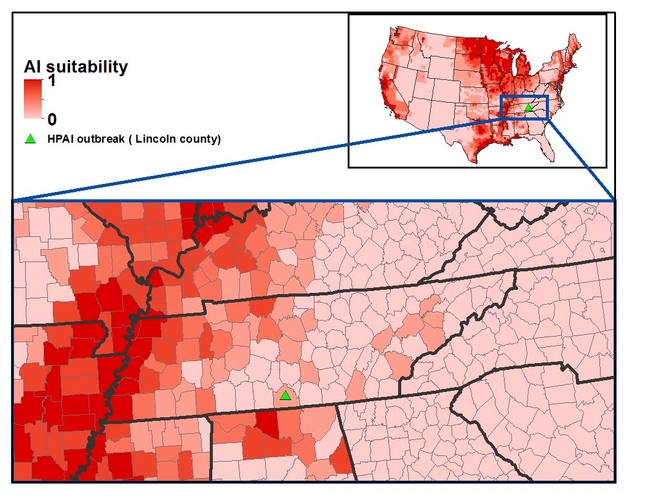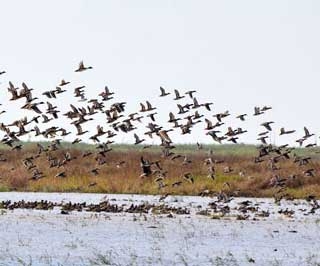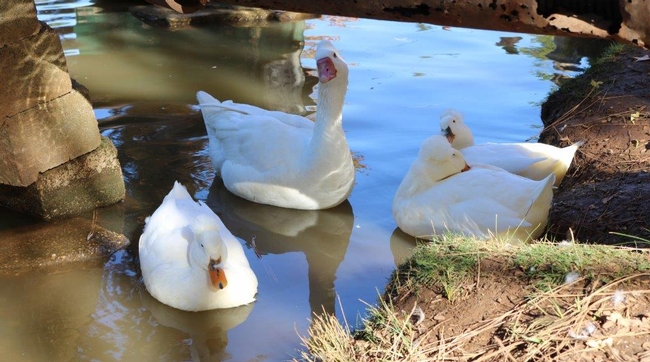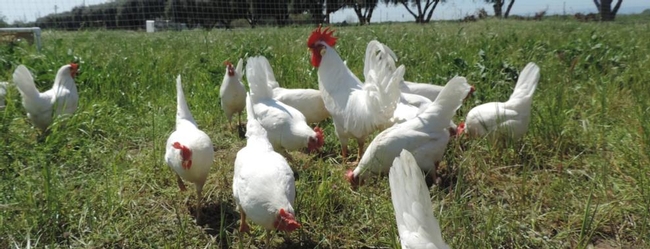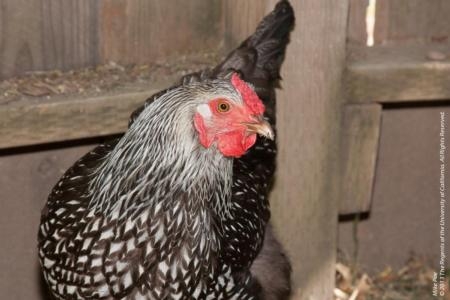Posts Tagged: Avian influenza
Protect your poultry from avian flu
University of California poultry experts are urging poultry owners to examine biosecurity for their flocks after avian influenza was confirmed in commercial chickens in Tennessee by the USDA Animal and Plant Health Inspection Service on Sunday (March 5). To protect the birds' health, UC scientists recommend taking measures to prevent poultry from coming into contact with wild birds.
"Based on the initial sequence of the virus, the source of the virus is thought to be waterfowl, said Maurice Pitesky, UC Cooperative Extension poultry specialist in the School of Veterinary Medicine at UC Davis. “This is consistent with the current understanding of how avian influenza spreads and evolves. Specifically, juveniles are infected at breeding locations and travel south in the fall carrying virus. As the waterfowl move southward, they are more likely to interact with other species, increasing the risk of interspecies transmission and formation of new varieties of avian influenza.”
The case in Lincoln County, Tenn., is the first report of highly pathogenic H7 avian influenza in commercial poultry in the United States this year. The flock of 73,500 affected chickens is located within the Mississippi Flyway, one of four North American flyways for migratory birds.
“Lincoln County is located in one of the medium-high risk areas that were identified by our risk map, said Beatriz Martínez López, director of the Center for Animal Disease Modeling and Surveillance in the School of Veterinary Medicine at UC Davis.
“We need to increase awareness of poultry producers to maximize the biosecurity implemented in their operations, particularly in those located in high risk areas, mainly farms that are in close proximity to wetlands or other wild bird feeding and resting areas,” said Martínez López.
Poultry owners can identify biosecurity strengths and weaknesses for their own farm or backyard flock by filling out a free survey designed by Martínez López and other poultry experts. People who raise chickens, quail, ducks, turkeys, geese or other birds anywhere in the United States are invited to use the resource. At the end of the survey, participants receive specific research-based recommendations of biosecurity measures they can apply on their own types of farms. The poultry biosecurity survey is available in English http://bit.ly/2kkMycf and Spanish http://bit.ly/2mjO13G. The survey takes 15 to 20 minutes to complete and will be open until June 1.
If you would like UC Cooperative Extension to notify you if there is an avian influenza outbreak in your area, sign up on the California Poultry Census page: http://ucanr.edu/sites/poultry/California_Poultry_Census.
Owners of backyard chickens who observe illness or increased mortality among their birds should call their veterinarian or the California Department of Food Agriculture sick bird hotline at (866) 922-BIRD (2473).
For more information about raising poultry, visit http://ucanr.edu/sites/poultry.
Are your birds safe from avian influenza?
To prevent outbreaks of this highly contagious virus in the United States, commercial and backyard poultry owners are being asked to fill out an online biosecurity survey. UC Agriculture and Natural Resources and UC Davis researchers are studying poultry-raising practices to help strengthen the industry's defenses against avian influenza.
“With changing migration patterns of wild birds and global movements of poultry, there is an urgent need to develop plans to protect U.S. poultry against highly pathogenic avian influenza,” said Beatriz Martínez López, director of the Center for Animal Disease Modeling and Surveillance in the School of Veterinary Medicine at UC Davis.
People who raise chickens, quail, ducks, turkeys, geese or other birds anywhere in the United States are invited to fill out the survey.
“We want to hear from all poultry producers: from the large commercial farms producing chicken eggs to the poultry enthusiasts who raise a few ornamental show birds in their backyards,” said Martínez López, who is part of the University of California's Agricultural Experiment Station.
The survey asks which bird species are being raised and a few flock management questions. Is the flock is housed or kept outdoors? How often do you get new birds? What is the source of new birds? It also asks questions about location, such as the distance of the birds from ponds and other bodies of water that may attract migrating waterfowl.
Immediately after completing the online survey, participants receive a biosecurity score and recommendations to help them make more informed decisions.
“Each producer will receive their own biosecurity score and customized recommendations,” Martínez López said. “Recommendations highly depend on the production system and we tried to adapt them to make the changes easier to implement for individual flocks.”
The survey data will be confidential and only summaries will be made publicly available in research reports and peer-reviewed publications.
By analyzing biosecurity and management practices on poultry operations and backyard flocks, Martínez López and visiting professor Sharmin Chowdhury will be able to identify high-risk locations and time periods for avian flu outbreaks. The information will be used to develop biosecurity education programs for poultry farmers, backyard producers and poultry veterinarians.
The survey takes about 15-20 minutes to complete. To participate, take the survey in English http://bit.ly/2kkMycf or Spanish http://bit.ly/2mjO13G by June 1.
This study is funded by Agriculture and Food Research Initiative Competitive Grant no. 2015–09118 from the USDA National Institute of Food and Agriculture.
[This news release has been updated to extend the survey deadline from March 1 to June 1 and to include a link to the survey in Spanish.]
MEDIA CONTACT:
Beatriz Martinez López, DVM, beamartinezlopez@ucdavis.edu, (530)752-7675.
California chickens at increased risk for severe 'bird flu' strain
UC Davis poultry experts are urging backyard chicken enthusiasts and commercial poultry owners to practice strong biosecurity measures to prevent contact with wild birds, due to highly pathogenic strains of avian influenza recently detected in migratory waterfowl in British Columbia, Washington, Oregon, and Butte County, California.
The current detected strains, H5N2 and H5N8, are not a risk to human health and have not been found in commercial poultry in the United States. However, commercial poultry flocks in British Columbia and backyard flocks in Washington and Oregon have been affected.
Avian influenza -- commonly called "bird flu" -- is a disease found in a wide variety of domesticated and wild birds. Once introduced into an area, infection can spread through bird-to-bird contact or through contact with contaminated clothing, shoes, hands, feed, water or equipment. Because waterfowl are reservoirs for avian influenza strains that can be fatal to domestic poultry (yet often show little to no signs in waterfowl), backyard and commercial chickens raised near areas commonly used by migrating waterfowl are at risk of transmission.
"Due to normal waterfowl migration along the Pacific Flyway, during the winter there are approximately eight times the number of waterfowl in California than what we will see three months from now," said Maurice Pitesky, a UC Cooperative Extension specialist with the UC Davis School of Veterinary Medicine. "There are lots of birds that winter and establish roosting and feeding habitat in California wetlands and agricultural crops. If you are a poultry owner -- either backyard or commercial -- and live in proximity to waterfowl and their habitat, your birds are at risk."
Owners of backyard chickens who observe illness or increased mortality in their birds should call their veterinarian or the California Department of Food Agriculture sick bird hotline at (866) 922-2473.
The California Animal Health and Food Safety Laboratory System includes four diagnostic labs in Davis, Turlock, Tulare and San Bernardino. The labs encourage veterinarians and owners of backyard chickens to submit sick or recently dead birds for necropsy (postmortem) examination. The exam is free of charge for California backyard flock owners of fewer than 1,000 birds (chicken, turkey, waterfowl and squabs). For more information, contact (530) 752-8700 or visit: <http://www.vetmed.ucdavis.edu/cahfs/>
Reduce the risk of bird flu
To reduce the risk of avian influenza transmission, chickens should be kept separate from wild birds and monitored for signs of illness or increased mortality. The CDFA also urges owners to take the following necessary and crucial precautions:
- If you have a pond or body of water that can attract waterfowl to or near your facility, consider draining if feasible.
- Provide housing to confine domestic poultry and/or enclose an exercise area with netting.
- Avoid use of water that comes from sources where waterfowl may congregate during migration.
- Ideally, owners of poultry should try to avoid waterfowl hunting during migration. Otherwise, ensure clothing, footwear, vehicles, etc. used during hunts are laundered and/or disinfected.
- Permit only essential workers and vehicles on premises and provide disposable coveralls, boots and head coverings for visitors.
- Clean and disinfect vehicles and equipment entering or leaving the premises.
- Control movement associated with the disposal of mortality, litter and manure.
Additional resources
Information on good biosecurity and hygiene precautions to keep backyard flocks healthy can be found at:
- UC Cooperative Extension: Backyard Poultry Resources: <http://ucanr.edu/sites/poultry/type/backyard>
- USDA Animal and Plant Health Inspection Service: <http://healthybirds.aphis.usda.gov>
- California Department of Food and Agriculture Avian Health Program: <http://www.cdfa.ca.gov/ahfss/Animal_Health/Avian_Health_Program.html>
Reports of dead, wild birds can be directed to the Wildlife Investigations Lab at (916) 358-2790. There is also a Web application for submission: http://bit.ly/17ESHWy.
The University of California Global Food Initiative aims to put the world on a path to sustainably and nutritiously feed itself. By building on existing efforts and creating new collaborations among UC's 10 campuses, affiliated national laboratories and the Division of Agriculture and Natural Resources, the initiative will develop and export solutions for food security, health and sustainability throughout California, the United States and the world.

